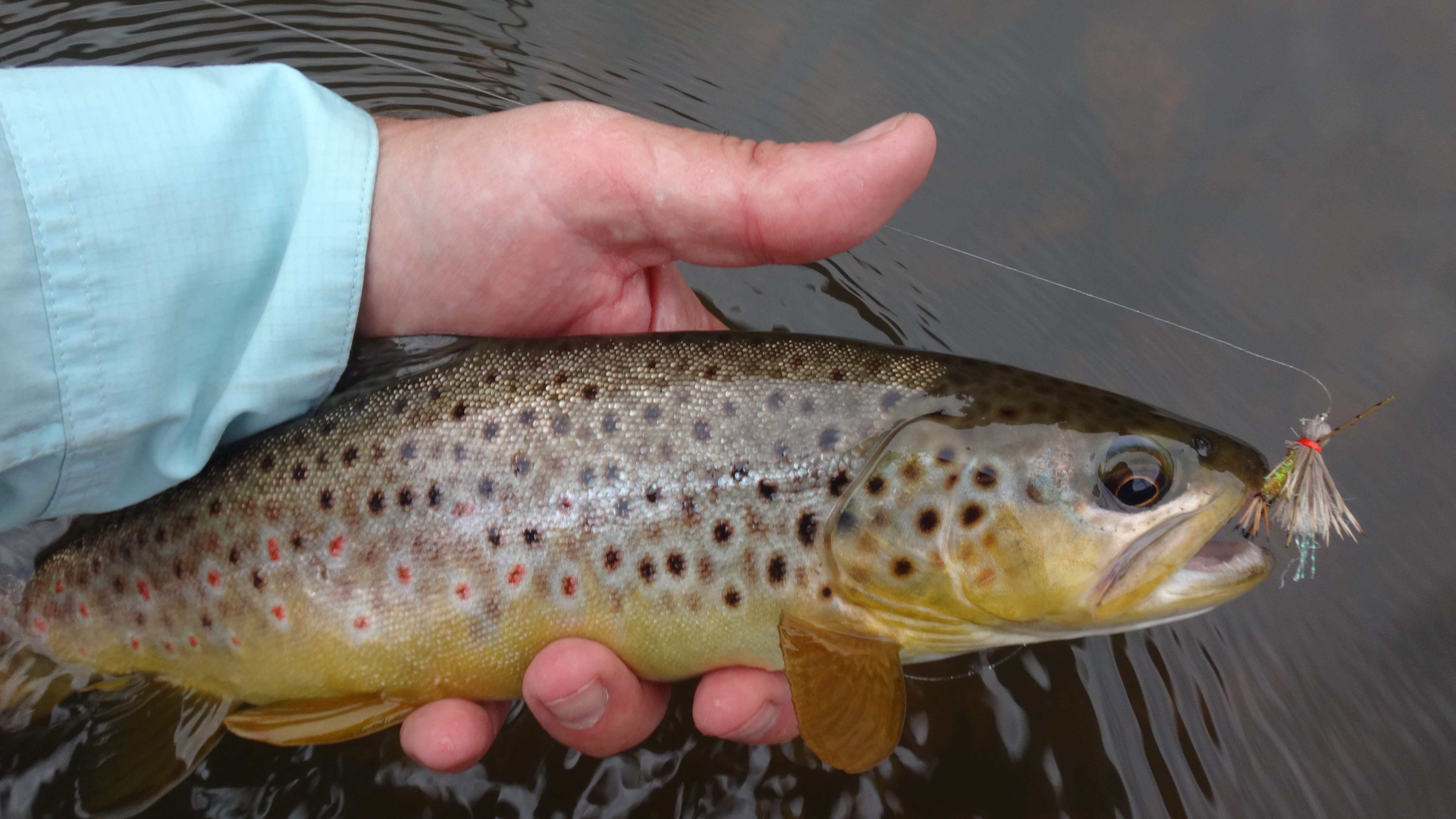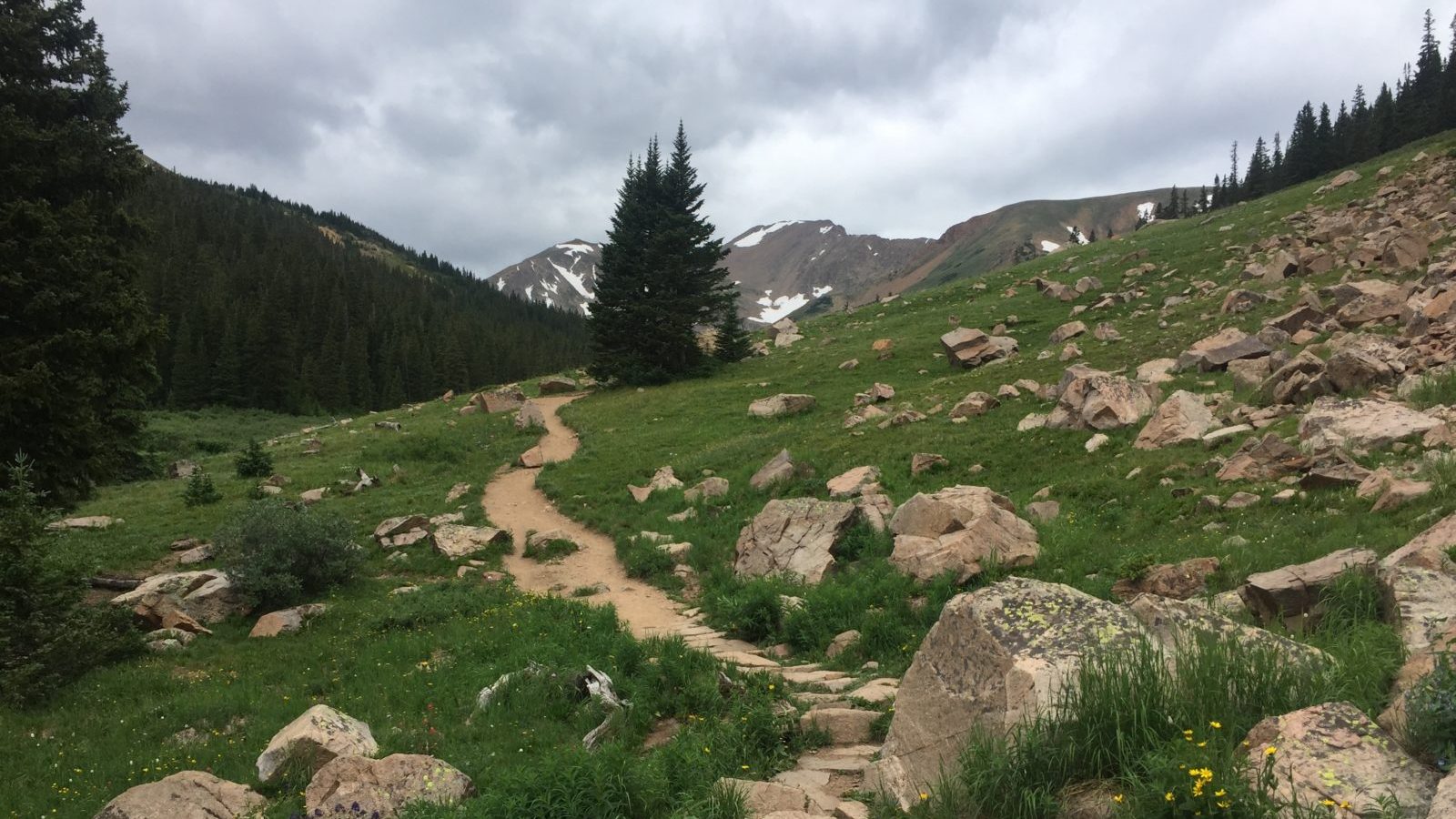I’m on a quest to catch a fish in each of the 50 U.S. states – and to use each adventure as a means to explore conservation, the latest fisheries research and our complicated connections to the natural world.
I hurriedly strung up my rod and headed out on the rocky Colorado trail, ready for one of the simplest of outdoor pleasures: small stream fly fishing. Generally, I find few crowds but plenty of eager fish. Generally.
After twenty minutes on the trail, I wondered if this might prove a lot less simple than I imagined. It was not the 10,500 feet of elevation that concerned me. Sure, the thin air sapped my breath, but I’ve hiked plenty at high elevations and have never had a problem.
No, it wasn’t the hike, but the “stream.” The trail zig-zagged up the mountain, but the stream ran straight down. It was more like a continuous, raging waterfall. I could not see how a trout could possibly cling to life here. The churning whitewater would surely send any fish cascading to its death.
Perhaps I should have known this outing would not be straightforward.
After all, the fish I sought had one of the most complicated conservation journeys imaginable. It had been declared extinct. Not once, but twice. It was initially doomed due to the interests of anglers. Then it was saved from the brink by the extinction of anglers.
And there’s the potential for this creature to have an even brighter and more prosperous future thanks to anglers. Maybe. Just maybe. But it’s going to mean that we learn from past mistakes and envision a somewhat different future for the sport of fly fishing.
Lost and Found
The fish is the greenback cutthroat trout. It was first declared extinct in the 1930s. But that was not the end of the story. The full saga of the greenback cutthroat is documented by Ted Williams in his recent Cool Green Science blog.

The condensed version is this: The greenback cutthroat was rediscovered in the 1970s, and listed as endangered. To garner angler support, the trout was downlisted to threatened to allow catch-and-release angling. Recovery efforts were spectacularly successful, with fish reintroduced to numerous streams and lakes throughout their original range.
And then, in the 2000s, genetic testing showed that these fish were not actually greenbacks, but of the Colorado River cutthroat subspecies. Was it lost again? Not quite. In the 1800s, a resort owner stocked trout in a fishless stream to draw more visitors to his lodge. Those trout were indeed pure greenback cutthroat trout. The recovery resumed and now greenbacks have been reintroduced into a couple of small streams, including the one I was now visiting.
Experts generally identify 14 subspecies of cutthroat trout, although the taxonomy is currently being reexamined. These trout are found exclusively in western North America, and have adapted to a wide variety of habitats and lifestyles. To my mind, they’re among the most beautiful fish, and each subspecies has its own spotting and coloration patterns.
While the greenback’s story is especially dramatic, most other cutthroat trout have faced similar challenges. Two subspecies are extinct. Almost all the others are now found in less than 10 percent of their historic waters.
A lot of the blame has to be shouldered by anglers. It’s true that cutthroats have suffered from many of the usual conservation threats, including overharvesting, water pollution, overgrazing and habitat degradation. But the fact is, the substantial loss of cutthroat subspecies across the Western United States is due to the stocking of non-native trout.
As sport anglers began visiting and moving to the West in the 1800s, they wanted to bring their familiar trout with them. They stocked them willy-nilly wherever they went. Cutthroat trout were considered inferior because their fight was deemed less spectacular, and sometimes because they were “too easy” to catch. As Ted Williams writes, “rod bending was perceived as the function of gamefish.” The sole function.

Brown trout from Europe ate cutthroats. Brook trout from the eastern United States out-competed them. And hatchery rainbow trout from the West Coast hybridized with them, breeding genetically pure cutthroats out of existence on many waters.
The remaining cutthroats hung on in remote wildernesses, tiny creeks and inaccessible waters. As biologists use ever-more sophisticated molecular sampling, they’re find that the genetics of cutthroats is much more diverse than originally thought. We can only guess how many native fish lineages were completely wiped out by stocking non-native trout.
Fortunately, there’s been a bit of an angler awakening. Cutthroat trout are not only being better protected, but restored. Most of the public, even conservationists, do not consider fish to be wildlife. It’s been hard to get any traction for native fish recovery (regardless of species) without angler support.
Interest in catching native trout builds every year. Some states, like Utah and Wyoming, now have “Cutt Slams.” Anglers attempt to catch the cutthroat subspecies in those states, and then receive a medallion upon completion. It’s one way to generate new interest in the variety that’s still out there. And more fly fishers value native habitats and the native trout that live there, arranging their trips around catching new subspecies and strains. It’s a great way to see the beauty of the West.
These are welcome developments. But as anglers, we need to do a lot more. Native cutthroat reintroduction, while a great conservation success, is often carried out on small, high-elevation streams. So-called “blue-ribbon” and “destination” trout streams remain largely the domain of introduced trout.

High-Elevation Jewels
As I hiked up the steep mountain gradient, the little raging torrent only seemed to get more frothy. Several people on the trail inquired about my fishing, wondering if I was hiking to a distant lake. When I told them I was seeking trout in this stream, the response was the same, “Fish can live in that?”
I was asking myself the same question. At times, I had the nagging suspicion I had gone to the wrong stream.
This stream had been stocked with pure-strain greenback cutthroats over the past several years. All non-native trout had been successfully removed. The first reintroduction of greenbacks appeared a bust. Monitoring the next year could find no survivors. The Colorado Department of Parks and Wildlife restocked it with larger trout. They survived, and reportedly, prospered.
I came across a field crew monitoring habitat conditions. I stopped and talked to researcher James Roberts, who told me that there were indeed greenbacks here, but I’d likely have to hike much farther. So I pressed on.
I hiked up higher, now above 11,000 feet, and the stream snaked through a meadow. Finally, the whitewater tapered off a bit. The water still looked shallow and unfishable, but some fallen logs had created an appealing pool.
I stalked close to it, tied on a bushy dry fly and cast into one of the deeper spots. I saw a flash. Or did I? I’m as guilty as any angler of wishful thinking, and I couldn’t be sure. I cast again to the same spot. Nothing.
A minute later, I saw a slight splash in the second-deepest spot in the whole. This time, there was no doubt. I had found some fish. I cast my fly to the sight of the rise, and immediately had a fish follow, but then it moved away without interest.
I downsized my fly to resemble the little insects I saw skittering on the surface. I cast again. The trout took.
There was no drama in the fight. I felt a bit overgunned with my little 3-weight fly rod. But soon I had to hand a beautiful jewel, a brightly colored, pure greenback cutthroat. I never lifted it from the water. I snapped a quick photo, slipped the barbless fly and the trout darted back to its pool.

I cast for 15 more minutes and caught two more beautiful little trout, surrounded by classic Rocky Mountain scenery.
I resumed hiking, thankful to have this encounter with a fish once declared extinct. But I couldn’t help but wonder what the future holds. It was easy to see why greenbacks were reintroduced to this particular. There was no blue-ribbon brown trout fishery, no guiding industry or fly shops catering to trophy-minded anglers. The high elevation and tininess of this stream meant it was always marginal trout habitat. Reintroducing natives here was a low risk endeavor.
But could we reintroduce greenbacks and other native fish more broadly in the West? It will take angler support, but many fear changes to their favorite blue-ribbon fishing waters. Still, anglers can change. At one point, fishing enthusiasts dumped buckets of non-native trout wherever they went regardless of consequences. Perhaps someday, values will change so that we demand returning native trout wherever we can.
I walked on, noticing thunder clouds looming. Still, as is so often the case, I wanted to see what was around the next bend. I wanted one more look at this fish that was once lost, now found. A trout that can maybe help guide us towards an exciting future for freshwater fish. And fishing.




Matthew,
Long ago in the Golden Trout Wilderness of the southern Sierra Nevada range I experienced the exhilaration of catching a native Golden trout in Nile Mile Creek south of Mt. Whitney. An experience that I have obviously never forgotten.
Swimmingly,
Gary E. Ranz
Great primer on cutthroat trout conservation, Matt. In addition to the two states you mention (Wyoming and Utah) that promote cutthroat trout conservation and restoration with “Cutt Slams,” Arizona, Nevada, and California have similar award programs for native salmonids, the latter two leaning heavily on cutthroat trout. The newest program of this sort is the Western Native Trout Challenge, sponsored by the Western Native Trout Initiative (WNTI), which includes 20 species of native salmonids in the 12 western states (https://westernnativetroutchallenge.org). WNTI is a cooperative organization among the western states that coordinates funding for native trout conservation projects.
Funny you should mention the perils of introduced trout right on the heels of a mustelid article. Here in NZ some ecologists are increasingly referring to brown and rainbow trout (both introduced) as “aquatic stoats” for the perceived damage they do to native fish and invertebrates.
Great article Matt, on so many levels. Thanks for your insights on the art of species survival.